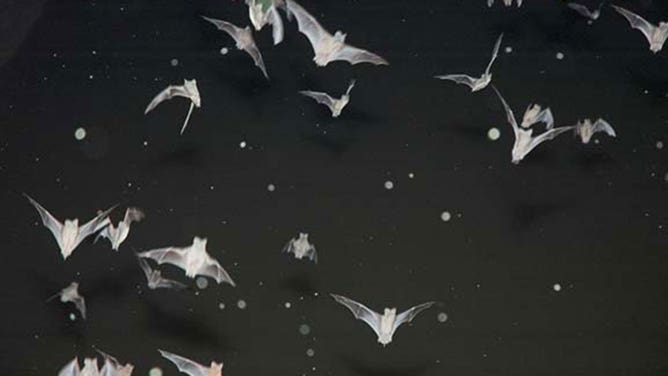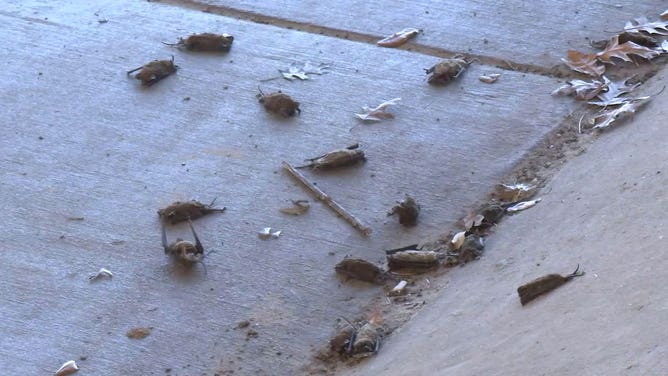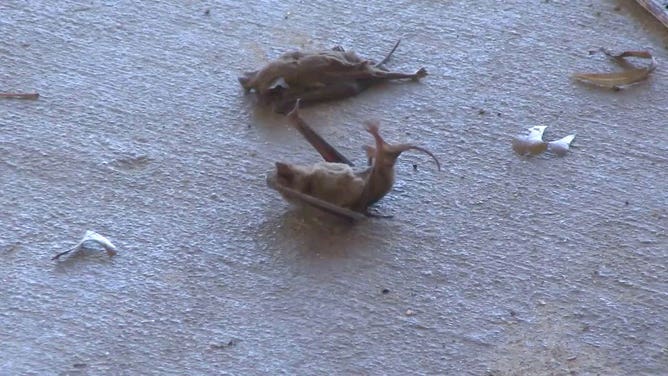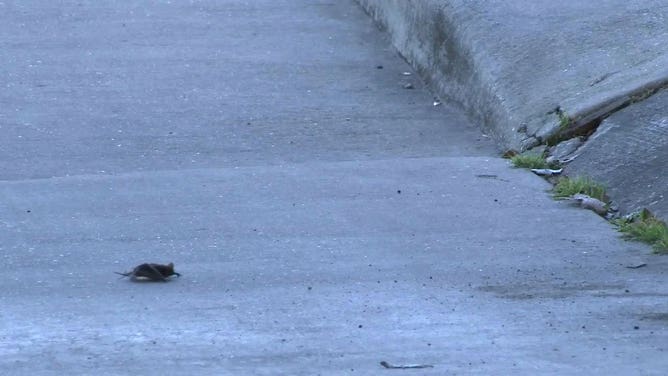Houston’s bridge bats took a hit during the 2021 Texas freeze. Here’s where they stand a year later
About 300,000 Mexican free-tailed bats call a bridge near downtown Houston home
Status of the Waugh Bridge bats in Houston after 2021 freeze
Houston's colony of bats that live under a bridge near downtown took a hit during the 2021 freeze. So where do things stand now? Diana Foss, of Texas Parks and Wildlife, explains.
HOUSTON – Not even a mile from downtown Houston is a colony of bats that have called the underside of a bridge home for nearly 30 years.
Diana Foss, an urban wildlife biologist with the Texas Parks and Wildlife Department, said about 300,000 Mexican free-tailed bats live in the crevices in the Waugh Drive bridge that spans the Buffalo Bayou.
Mexican free-tailed bats, which are called Brazilian free-tailed bats in other parts of the world, are medium-sized bats. They have a wingspan of about a foot and have reddish, brown or gray fur. Their tail extends farther than most other bats, and they feast on insects, especially moths.

Mexican free-tailed bats are seen under the Waugh Bridge in Houston.
(Dale Martin)
The bats are common in Texas, with colonies scattered across the state. Texas lawmakers named them the state’s flying mammal in 1995. Houston’s colony is one of the smaller groupings in Texas. Austin has a colony of about 1.5 million that live under a bridge near the city center. Bracken Cave, near San Antonio, is home to the largest bat colony in the world with a population of 15 million.
WHAT IT WAS LIKE TO LIVE AND WORK IN HOUSTON DURING TEXAS’ CRIPPLING 2021 WINTER STORM
In Houston, the bats have become a tourist attraction and point of pride for locals. Just after sunset, the animals emerge from the bridge to hunt for insects. People gather on the banks of the bayou to watch the natural spectacle each evening.
"Houston’s got this little treasure right near downtown," Foss said. "It’s super easy and it’s free, and it happens every night, unless it’s cold."

Mexican free-tailed bats fly under the Waugh Drive bridge in Houston.
(Dale Martin)
Freeze put colony on ice
Foss said the ideal temperature for the bats is above 50 degrees. Anything less than that, and the bats enter a type of deep sleep called torpor, when their body temperature and metabolic rates are reduced to conserve energy.
"Everything kind of slows down, and they just stay up in the bridge crevice, up as high up as they can get, up close to the road, right to where the road goes across, because that collects heat," Foss said. "So it keeps them a little bit warm, and they just live off body fat. They have to wake up periodically, to go and find water, solely because they can dehydrate pretty quickly, and that's what got them in the freeze."
The freeze Foss is referencing is the February 2021 winter storm that plunged Texas into arctic temperatures for days.
According to Foss, the bulk of the colony heads south to caves in Mexico for the winter. About 100,000 of the bats, mostly the younger members of the brood, opt to ride out the colder months under the bridge.
The prolonged stretch of subfreezing temperatures last year proved detrimental to the ones who stayed behind.
"It hit right at the tail end of what's typically our winter," Foss said. "So the bats are at the tail end of their body fat stores. So they've, you know, they've built up body fat all summer long, eating insects and storing that fat away under their skin, and they're starting to run out by the … end of February."
Foss said another problem the bats faced is that they do not fly well in cold weather, which is critical for their ability to hydrate.
"They don't do like a dog or cat and walk up to water and lap at the water," Foss said. "They fly over the water, dip down and get a mouthful of water and then come back up and dip back down and get another mouthful of water. So, they're flying over and dipping down and getting water, mouthfuls of water, and that's usually how they drink. So, it's pretty hard if you're cold already, and you're having a hard time flying to get that water that you need."
In the days that followed the freezing temperatures, people who walk or bike along the paths that pass under the bridge started reporting seeing dead bats on the ground. According to Foss, about 5,000 of the 100,000 bats that stayed for the winter died.
IS THE TEXAS POWER GRID READY FOR THE NEXT GREAT FREEZE? THE ANSWER IS MIXED
"I think the thing that was so startling was seeing 5,000 all at once, you know, because it was like a two-day constant, you know, here's bats on the ground," Foss said.
Foss said about 200 cold-stunned bats were recovered and were taken to a rehabilitation facility. The ones that survived were released back into the wild.
Houston's colony was not alone. According to Foss, bats in colonies across the state were also killed by the widespread subfreezing temperatures.
"So in Austin and all through the Hill Country, places that had little populations of Mexican free-tailed bats, everybody started reporting, 'Uh oh! We have a problem,'" Foss said. "And then the poor wildlife rehabilitators were getting inundated with, you know, bats that were in trouble."
Bouncing back
According to Foss, the Waugh Bridge bats have made a remarkable comeback in the year that has passed since the freeze.
"I would think we're pretty much back to normal now because they had that summer to give birth to pups," Foss said. "So, you know, they've replenished their population for that year. So they're probably back up close to that 300,000 number again now."
She said the bats will begin their annual return to Houston beginning at the end of February through March and will spend the warm months doing what they do best – eating insects.

Mexican free-tailed bats are seen crammed into one of the crevices on the bottom of the Waugh Drive bridge in Houston.
(Dale Martin)
Future challenges
Foss said the biggest challenge the bats face is the loss of habitat, whether that’s in the Houston area or on their journey to and from Mexico each year.
"Places where the bats typically would, even if they migrated and they come back this direction, places where they used to stop and rest during the day -- that place is gone now," Foss said. "So, they have to find alternative roosts or different places to try and hang out."
GREAT TEXAS FREEZE KILLED NEARLY 3 TIMES MORE PEOPLE THAN HURRICANE HARVEY
Foss said one thing going for the Mexican free-tailed variety of bats is that they do not seem to be affected by white-nose syndrome, a deadly disease that is caused by a fungus.
"They can get the fungus on them, but they don't do the whole deep hibernation thing, and so the fungus doesn't seem to affect them that much," Foss said.
Importance of the colony
One of the biggest roles Houston’s colony plays is helping people understand bats better and the role they play in our ecosystem.
Foss said the Houston colony is a maternity ward of sorts for the animals, meaning the adults bats fly north and have their babies under the bridge during the warm months.

Mexican free-tailed bats emerge from the Waugh Drive bridge in downtown Houston.
(Dale Martin)
"So, it's full of baby bats all through the summertime," Foss said. "If you go down right around July 4th, that's when the first of the baby bats start to fly. So, they come out and do little test flights all around the bridge area."
The Texas Parks and Wildlife Department hosts chats on Friday nights from March to October about 30 minutes before sunset. There is also a boat ride on Buffalo Bayou that culminates in watching the bats emerge.





